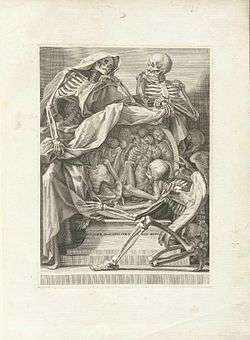Bernardino Genga
Bernardino Genga (1620–1690) was a scholar of Classical medical texts, editing several works of Hippocrates. He also had a great interest in the preparation of anatomical specimens as well as the anatomy of ancient Greek and Roman sculpture. These interests led to his work at the French Academy in Rome, where he taught anatomy to artists.

He was born in Mondolfo in the Duchy of Urbino and died in Rome, where he practiced surgery in the Hospital of Santo Spirito in Sassia and San Giacomo degli Incurabili.
In 1672, he published his noted Anatomia Chirurgica, a textbook for surgeons which went through a number of editions. A year after his death was published the beautiful Anatomia per Uso et Intelligenza del Disegno, which consisted of renderings of his anatomical preparations by the artist Charles Errard (1606–1689), director of the Accademia, and most likely engraved by François Andriot (died 1704). Giovanni Maria Lancisi (1654–1720), the Papal physician, edited the work and provided much of the commentary.
Anatomia per Uso et Intelligenza del Disegno consists of 59 copperplate engravings of text and illustrations printed on one side only. After the engraved title is a plate with allegorical emblems of death. Of the illustrated plates, the first 23 deal with osteology and myology drawn from Genga's anatomical preparations. The remainder consists of representations of antique statues viewed from different angles, including the Farnese Hercules, the Laocoön (without his sons), the Borghese Gladiator, the Borghese Faun, the Venus de Medici, the Youth Pulling a Thorn from his Foot, and the Amazon of the House of Cesi. A variant of this work lacks the final three images and contains the words "libro primo" on the engraved title, though there was never a libro "secundo" published.
An English translation of the work appeared in London in 1723 under the title, Anatomy Improv'd.
Sources
- Adapted from public domain text at Bernardino Genga Biography. Historical Anatomies on the Web. US National Library of Medicine.
References
- Amati, G. Bibliografia Romana: notizie della vita e delle opere degli scrittori Romani dal secolo XI fino ai nostri giorni. (Roma: Tipografia Eredi Botta, 1880). pp. 131–132.
- Choulant, L. History and bibliography of anatomic illustration. Trans. and annotated by Mortimer Frank. (New York: Hafner, 1962). pp. 254–255.
- Morton's Medical Bibliography (Garrison and Morton). Ed. By Jeremy Norman. Fifth ed. Aldershot, Hants, England : Scolar Press; Brookfield, Vt., USA : Gower Pub. Co., 1991. No. 386.
External links
| Wikimedia Commons has media related to Bernardino Genga. |
- Historical Anatomies on the Web. US National Library of Medicine. Selected pages scanned from the original work, Anatomia per Uso et Intelligenza del Disegno (Rome, 1691).